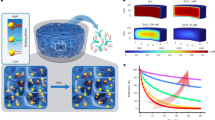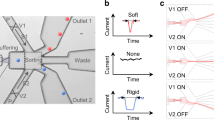Abstract
The efficient extraction of (bio)molecules from fluid mixtures is vital for applications ranging from target characterization in (bio)chemistry to environmental analysis and biomedical diagnostics. Inspired by biological processes that seamlessly synchronize the capture, transport and release of biomolecules, we designed a robust chemomechanical sorting system capable of the concerted catch and release of target biomolecules from a solution mixture. The hybrid system is composed of target-specific, reversible binding sites attached to microscopic fins embedded in a responsive hydrogel that moves the cargo between two chemically distinct environments. To demonstrate the utility of the system, we focus on the effective separation of thrombin by synchronizing the pH-dependent binding strength of a thrombin-specific aptamer with volume changes of the pH-responsive hydrogel in a biphasic microfluidic regime, and show a non-destructive separation that has a quantitative sorting efficiency, as well as the system's stability and amenability to multiple solution recycling.
This is a preview of subscription content, access via your institution
Access options
Subscribe to this journal
Receive 12 print issues and online access
$259.00 per year
only $21.58 per issue
Buy this article
- Purchase on Springer Link
- Instant access to full article PDF
Prices may be subject to local taxes which are calculated during checkout





Similar content being viewed by others
References
Fratzl, P. & Barth, F. G. Biomaterial systems for mechanosensing and actuation. Nature 462, 442–448 (2009).
Stuart, M. A. C. et al. Emerging applications of stimuli-responsive polymer materials. Nature Mater. 9, 101–113 (2010).
Cabodi, M., Chen, Y. F., Turner, S. W. P., Craighead, H. G. & Austin, R. H. Continuous separation of biomolecules by the laterally asymmetric diffusion array with out-of-plane sample injection. Electrophoresis 23, 3496–3503 (2002).
Cho, E. J., Collett, J. R., Szafranska, A. E. & Ellington, A. D. Optimization of aptamer microarray technology for multiple protein targets. Anal. Chim. Acta 564, 82–90 (2006).
Eigen, M. & Rigler, R. Sorting single molecules—application to diagnostics and evolutionary biotechnology. Proc. Natl Acad. Sci. USA 91, 5740–5747 (1994).
Song, Y. A., Hsu, S., Stevens, A. L. & Han, J. Y. Continuous-flow pI-based sorting of proteins and peptides in a microfluidic chip using diffusion potential. Anal. Chem. 78, 3528–3536 (2006).
Fu, J., Mao, P. & Han, J. Artificial molecular sieves and filters: a new paradigm for biomolecule separation. Trends Biotechnol. 26, 311–320 (2008).
He, X., Li, C., Chen, F. G. & Shi, G. Q. Polypyrrole microtubule actuators for seizing and transferring microparticles. Adv. Funct. Mater. 17, 2911–2917 (2007).
Zhao, Q., Li, X-F. & Le, X. C. Aptamer capturing of enzymes on magnetic beads to enhance assay specificity and sensitivity. Anal. Chem. 83, 9234–9236 (2011).
Levy-Nissenbaum, E., Radovic-Moreno, A. F., Wang, A. Z., Langer, R. & Farokhzad, O. C. Nanotechnology and aptamers: applications in drug delivery. Trends Biotechnol. 26, 442–449 (2008).
Sengupta, S. et al. Self-powered enzyme micropumps. Nature Chem. 6, 415–422 (2014).
Koga, S., Williams, D. S., Perriman, A. W. & Mann, S. Peptide–nucleotide microdroplets as a step towards a membrane-free protocell model. Nature Chem. 3, 720–724 (2011).
Maitz, M. F. et al. Bio-responsive polymer hydrogels homeostatically regulate blood coagulation. Nature Commun. 4, 2168 (2013).
Rodriguez-Llansola, F. & Meijer, E. W. Supramolecular autoregulation. J. Am. Chem. Soc. 135, 6549–6553 (2013).
Wang, J. B. & Feringa, B. L. Dynamic control of chiral space in a catalytic asymmetric reaction using a molecular motor. Science 331, 1429–1432 (2011).
Wilson, D. A., Nolte, R. J. M. & van Hest, J. C. M. Autonomous movement of platinum-loaded stomatocytes. Nature Chem. 4, 268–274 (2012).
He, X. et al. Synthetic homeostatic materials displaying chemo-mechano-chemical self-regulation. Nature 487, 214–218 (2012).
de Ruiter, G. & van der Boom, M. E. Surface-confined assemblies and polymers for molecular logic. Acc. Chem. Res. 44, 563–573 (2011).
Krieg, E., Weissman, H., Shirman, E., Shimoni, E. & Rybtchinski, B. A recyclable supramolecular membrane for size-selective separation of nanoparticles. Nature Nanotech. 6, 141–146 (2011).
Hirokawa, N. Kinesin and dynein superfamily proteins and the mechanism of organelle transport. Science 279, 519–526 (1998).
Cho, E. J., Lee, J. W. & Ellington, A. D. Applications of aptamers as sensors. Ann. Rev. Anal. Chem. 2, 241–264 (2009).
Mosing, R. K. & Bowser, M. T. Microfluidic selection and applications of aptamers. J. Sep. Sci. 30, 1420–1426 (2007).
Jeong, B. & Gutowska, A. Lessons from nature: stimuli-responsive polymers and their biomedical applications. Trends Biotechnol. 20, 305–311 (2002).
Yerushalmi, R., Scherz, A., van der Boom, M. E. & Kraatz, H. B. Stimuli responsive materials: new avenues toward smart organic devices. J. Mater. Chem. 15, 4480–4487 (2005).
Krieg, E. et al. Supramolecular gel based on a perylene diimide dye: multiple stimuli responsiveness, robustness, and photofunction. J. Am. Chem. Soc. 131, 14365–14373 (2009).
Macaya, R. F., Schultze, P., Smith, F. W., Roe, J. A. & Feigon, J. Thrombin-binding DNA aptamer forms a unimolecular quadruplex structure in solution. Proc. Natl Acad. Sci. USA 90, 3745–3749 (1993).
Tasset, D. M., Kubik, M. F. & Steiner, W. Oligonucleotide inhibitors of human thrombin that bind distinct epitopes. J. Mol. Biol. 272, 688–698 (1997).
Srinivas, R. L., Chapin S. C. & Doyle, P. S. Aptamer-functionalized microgel particles for protein detection. Anal. Chem. 83, 9138–9145 (2011).
Cheng, M. M. C. et al. Nanotechnologies for biomolecular detection and medical diagnostics. Curr. Opin. Chem. Biol. 10, 11–19 (2006).
Guo, M. T., Rotem, A., Heyman, J. A. & Weitz, D. A. Droplet microfluidics for high-throughput biological assays. Lab Chip 12, 2146–2155 (2012).
Martinez, A. W., Phillips, S. T., Whitesides, G. M. & Carrilho, E. Diagnostics for the developing world: microfluidic paper-based analytical devices. Anal. Chem. 82, 3–10 (2010).
Dick, L. W. & McGown, L. B. Aptamer-enhanced laser desorption/ionization for affinity mass spectrometry. Anal. Chem. 76, 3037–3041 (2004).
He, X., Friedlander, R. S., Zarzar, L. D. & Aizenberg, J. Chemo-mechanically regulated oscillation of an enzymatic reaction. Chem. Mater. 25, 521–523 (2013).
Bhattacharya, A. & Balazs, A. C. Stiffness-modulated motion of soft microscopic particles over active adhesive cilia. Soft Matter 9, 3945–3955 (2013).
Hianik, T. O. V., Sonlajtnerova, M. & Grman, I. Influence of ionic strength, pH and aptamer configuration for binding affinity to thrombin. Bioelectrochemistry 70, 127–133 (2007).
Baldrich, E., Restrepo, A. & O'Sullivan, C. K. Aptasensor development: elucidation of critical parameters for optimal aptamer performance. Anal. Chem. 76, 7053–7063 (2004).
Bock, L. C., Griffin, L. C., Latham, J. A., Vermaas, E. H. & Toole, J. J. Selection of single-stranded DNA molecules that bind and inhibit human thrombin. Nature 355, 564–566 (1002).
Zeng, Y. & Harrison, D. J. Self-assembled colloidal arrays as three-dimensional nanofluidic sieves for separation of biomolecules on microchips. Anal. Chem. 79, 2289–2295 (2007).
Arakawa, T., Shirasaki, Y., Aoki, T., Funatsu, T. & Shoji, S. Three-dimensional sheath flow sorting microsystem using thermosensitive hydrogel. Sensor Actuator A 135, 99–105 (2007).
Doyle, P. S., Bibette, J., Bancaud, A. & Viovy, J. L. Self-assembled magnetic matrices for DNA separation chips. Science 295, 2237–2237 (2002).
Pedersen, J., Petersen, G. E., Lauritzen, C. & Arnau, J. Current strategies for the use of affinity tags and tag removal for the purification of recombinant proteins. Protein Expres. Purif. 48, 1–13 (2006).
Chen, L. et al. Aptamer-mediated efficient capture and release of T lymphocytes on nanostructured surfaces. Adv. Mater. 23, 4376–4380 (2011).
Zhang, L., Chatterjee, A. & Leung, K. T. Hydrogen-bond-mediated biomolecular trapping: reversible catch-and-release process of common biomolecules on a glycine-functionalized Si(111)7×7 Surface. J. Phys. Chem. Lett. 1, 3385–3390 (2010).
Jayasena, S. D. Aptamers: an emerging class of molecules that rival antibodies in diagnostics. Clin. Chem. 45, 1628–1650 (1999).
Wochner, A. et al. A DNA aptamer with high affinity and specificity for therapeutic anthracyclines. Anal. Biochem. 373, 34–42 (2008).
Zhai, G., Iskander, M., Barilla, K. & Romaniuk, P. J. Characterization of RNA aptamer binding by the Wilms’ tumor suppressor protein WT1. Biochemistry 40, 2032–2040 (2001).
Lin, Y., Qiu, Q., Gill, S. C. & Jayasena, S. D. Modified RNA sequence pools for in vitro selection. Nucleic Acids Res. 22, 5229–5234 (1994).
Schurer, H. et al. Aptamers that bind to antibiotic moenomycin A. Bioorg. Med. Chem. 9, 2557–2563 (2001).
Li, T., Shi, L., Wang, E. & Dong, S. Multifunctional G-quadruplex aptamers and their applications to protein detection. Chem. Eur. J. 15, 1036–1042 (2009).
Fujita, H. et al. Structural and affinity analyses of G-quadruplex DNA aptamers for camptothecin derivatives. Pharmaceuticals 6, 1082–1093 (2013).
Acknowledgements
This work was supported by the Department of Energy under Award No. DE-SC0005247. We thank M. Krogsgaard and C. Howell for their help with the XPS characterization of the aptamer functionalization of the microstructures.
Author information
Authors and Affiliations
Contributions
X.H., A.S., L.M.M., M.A., A.C.B. and J.A. designed the project. X.H., A.S., L.M.M., M.A., O.K., A.C.B. and J.A. wrote the manuscript. Y.L., A.B., Y.M., O.K. and A.C.B. performed the computational simulations and analysed the results. L.M.M. and V.H. performed the PAGE experiments and analysis, and participated in synthesizing the DNA aptamers. X.H. and A.S. conducted the catch-and-release experiments in the microfluidic system and performed the ELISA analysis. X.H., A.S., H.N., M.M. and V.H. conducted the ELONA experiments. A.S. performed the experiments to determine the pH-dependent behaviour of the aptamers. X.H. performed a confocal microscopy characterization of the system. Y.V., O.K. and M.A. contributed important discussions to the analysis of the results.
Corresponding authors
Ethics declarations
Competing interests
The authors declare no competing financial interests.
Supplementary information
Supplementary information
Supplementary information (PDF 2966 kb)
Rights and permissions
About this article
Cite this article
Shastri, A., McGregor, L., Liu, Y. et al. An aptamer-functionalized chemomechanically modulated biomolecule catch-and-release system. Nature Chem 7, 447–454 (2015). https://doi.org/10.1038/nchem.2203
Received:
Accepted:
Published:
Issue Date:
DOI: https://doi.org/10.1038/nchem.2203
This article is cited by
-
Theoretical study of chaotic jumping of liquid crystal elastomer ball under periodic illumination
Nonlinear Dynamics (2024)
-
Increasing flow rates in polydimethylsiloxane-based deterministic lateral displacement devices for sub-micrometer particle separation
Microfluidics and Nanofluidics (2023)
-
Non-equilibrium signal integration in hydrogels
Nature Communications (2020)
-
Artificial phototropism for omnidirectional tracking and harvesting of light
Nature Nanotechnology (2019)
-
pH-responsive nanosystems based on reduced graphene oxide grafted with polycaprolactone-block-poly(succinyloxyethylmethacrylate) for doxorubicin release
Journal of the Iranian Chemical Society (2019)



